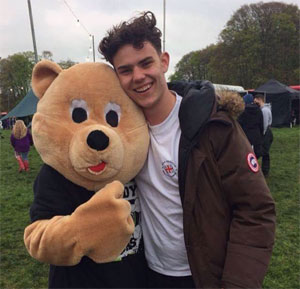
Lucy Trevelyan LLB
NCTJ-qualified journalist

Cameron is a Biomedical Engineering student currently studying at Nottingham Trent University. Cameron grew up in Kenya before moving to Dorset, and then settling in Nottingham to further his studies.
The brother of Cameron’s partner suffers with Epilepsy, which is what inspired his seizure detecting pillow design. He was also inspired after watching Netflix documentary “Dogs”, in which an episode detailed the expense and impact that epilepsy can have on a person’s life, and wanted to help come up with a cost-effective solution.
A fibreoptic pillowcase to detect nighttime seizures. It will contain a a network of fibreoptic cables with strain FGB sensors to detect small rapid movements in the sleep, the muscle spasms that take place during a seizure, to alert a carer to help. The pillow is designed to be portable, therefore allowing the user the ability to sleep safely in places other than their own bed (for example, a child might be able to take this to a friend’s house for a sleepover).
The idea is to make a network of fibreoptic cables with strain FGB sensors to detect small rapid movements in the sleep, the muscle spasms that take place during a seizure, to alert a carer to help. The main benefit of this system is that it is a cost effective and portable detection system that will free the user to be able to sleep in other beds, for younger kids this will allow the user to have sleep overs and go on nights away. Another benefit is that as the data is collected it can time how long and how often the seizures are, allowing doctors to review how effective the treatment is.
A cheaper alternative can also be used with fabric pressure sensors but is less accurate. Both methods follow the same principle of detection of movements during the seizure but to varying degrees of success. The pillow will be knitted making it anti-suffocation so stop them from person choking on the pillow during a seizure. I have chosen this because my partners brother has stressed induced epilepsy. When the pillow finds an abnormal movement that surpasses the baseline the pillow will be attached to a radio antenna that will signal to the receivers in the carers hands, setting off the alarm.
This pillow is designed for young kids who suffer from night time fits. It can also be applied to adults with more neutral colour schemes. This is designed to help people with seizures but can be applied to monitor movement of the head during sleep. It can also help detect the stages of sleep going into REM sleep. The system can either be on a schedule or turned on/off to stop false alarms that may be set off by animals on the pillow.
There are currently two main types of detection system (epilepsy.org.uk, 2018). The first is wristbands that will monitor heart rate which are ranging from £800 – £1600. This system is portable but needs charging during the night time, this invention covers the time the wristband is not on.
The second is a movement-based system for the beds that will be under the mattress for £300 to £800 plus expenses such as radio receivers for carers (epilepsy.org.uk, 2018). Some have the addition of detecting sound but at an additional cost. I got the idea after watching the program ‘Dogs’ on Netflix about how difficult it is to train dogs to detect seizures for young children. I thought there must be a cheaper better way that allows young kids not to be in danger when they sleep. Training of these dogs can cost between £7000-£20000 (speakdogtricities.com, 2018).
The use of Fibre Bragg grating uses a UV laser a few millimetres in length within a single normal fibreoptic cable. It detects changes in pressure after signal processing. The changes will be a movement of the peak of the wavelength along the x axis with lighter pressure moving the peak to the left and more pressure moving to the right (Hill, K.O. and Meltz, G., 1997). This will allow to detect small rapid changes in the movement during their sleep. The FGB sensors individually collect the data along the fibre optic cable and transmits it to the interrogator. There will be an increased number of sensors on the pillow with the fibreoptic sensors increasing the detection rate.
For the design there will be 16 FGB sensors placed every 60 cm. They will be laid on a plate that will be slotted into the pillow. The pillow will contain 3 layers of the lay configuration with 1-3mm thick stainless-steel in-between to stop the fiberoptic cables from over extending. The stainless steel with have holes through it to allow the user to breathe through the pillow. This does not change the outside of the pillow as it still has to be anti-suffocation. The sensors will be evenly distributed to create an even image. The pillow will be a king size to reduce the change of the person moving off the pillow.
Fabric pressure sensors are a cheaper but less sensitive method. It works by detecting changes in resistance when the conductive material is stressed. This can be detected and achieved using a simple circuit board, but testing can use a raspberry pi. Some people may be against the idea of using this as there will be electrical signals in the pillow next to a person head. Insulating the whole mechanism will combat this. There will be a total of 16 cables each with a sensor that is attached to the Pi. The configuration will be on both sides of the pillow allowing the user to flip it over as well as one in the middle to support the two on each side.
It will be made using 0.8mm copper wire as it is the simplest conductive fiber to use encased in rubber coating for insulation. It will then be woven into the pillow in hallow tubes to keep them in place.
There will be 16 sensors connected with wires to the raspberry pi. The pillow will be a king size to reduce the change of the person moving off the pillow.
When tuning to detect a seizure there will need to be data collected with the pillow with a person who does not suffer fits. This will have to be collected over several nights and will have to detect when the person first lays down and gets up in the morning. Then the data will have be processed to look for pattern of typical sleep and the ranges of movement. Then either assumptions will have to be made if out of the range is a seizure or the pillow will have to be used by someone who is prone to seizures. This will allow for a baseline to be made. Once the detection system is calibrated a simpler cheaper interrogator can be used that is pre programmed.
The pillow will have to be anti-suffocation as during a fit the person may turn over. This mean they must be able to breath into the pillow through holes that are within the memory foam. This will mean it’s a knitted pillow case with the sensors woven in. The pillow will be a tightly woven knit with a high tension so the sensor strips will not move during the night. It will be made out of Elastelle (Merino & Elastane) so it can stretch. The fabric sensors will be laid against the bias to also reduce movement.
The colour schemes will be relaxing colours that help with sleep such as Blue, Yellow, Orange, Silver and pink with patterns.
The pillow will have a egg carton type design as well as holes throughout a the layers to allow airflow when the head is in the pillow. The main solid green block is the dense memory foam with the lighter peaks of less dense memory foam that will compress making the pillow softer and better to sleep on. It will follow the design below.
When you submit your details, you'll be in safe hands. Our partners are National Accident Helpline (a brand of National Accident Law, a firm of personal injury solicitors regulated by the Solicitors Regulation Authority). They are the UK's leading personal injury service. Their friendly legal services advisers will call you to talk about your claim and give you free, no-obligation advice. National Accident Law may pay us a marketing fee for our services.
By submitting your personal data, you agree for your details to be sent to National Accident Law so they can contact you to discuss your claim.
If you win your case, your solicitor's success fee will be taken from the compensation you are awarded - up to a maximum of 25%. Your solicitor will discuss any fees before starting your case.
Our experts